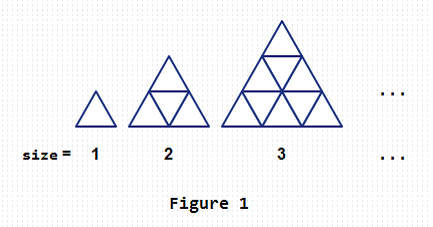Downward paths
Time Limit: 2000/1000 MS (Java/Others) Memory Limit: 32768/32768 K (Java/Others)
Total Submission(s): 844 Accepted Submission(s): 282
Problem Description
================
================
We have a graph with size = N like that in Figure 1. Then we are going to find a downward path from the top node to one bottom node.
First, we select the top node as the beginning. Then at any node, we can go horizontally or downward along the blue edge and reach the next node. The finding will be end when we reach one of the bottom nodes. After that we can get a downward path from the top node to one bottom node. Note that we can not pass a blue edge that we have passed ago during each finding.
Your task is to calculate there exists how many downward paths.

Hi! I am an ACMer from CSU. This contest made by me is to celebrate my girlfriend’s birthday although the problems in this contest do not relate to her in fact. :) Any way, happy birthday to you, honey!
Thanks to LCY, I have this chance to share my ideas and works with you. Good luck and have fun!================
We have a graph with size = N like that in Figure 1. Then we are going to find a downward path from the top node to one bottom node.
First, we select the top node as the beginning. Then at any node, we can go horizontally or downward along the blue edge and reach the next node. The finding will be end when we reach one of the bottom nodes. After that we can get a downward path from the top node to one bottom node. Note that we can not pass a blue edge that we have passed ago during each finding.
Your task is to calculate there exists how many downward paths.

Input
There is an integer T (1 <= T <= 1000) in the first line, which indicates there are T test cases in total.
For each test case, there is only one integer N (1 <= N <= 10^18) indicates the size of the graph.
For each test case, there is only one integer N (1 <= N <= 10^18) indicates the size of the graph.
Output
For each test case, you should output the correct answer of the above task in one line.
Because the answer may be very large, you should just output the remainder of it divided by 1000003.
Because the answer may be very large, you should just output the remainder of it divided by 1000003.
Sample Input
2
1
2
Sample Output
2
8

Hint
For Sample 2, the yellow paths in Figure 2 show the 8 downward paths.
********************************************************************************************
题意:从顶点走到底有多少条路可以走
解题思路:
size = 1时:2*(1+0) = 2
size = 2时:2*(1+1) *2(1+0)= 8
size = 3时:2*(1+1)*2*(1+2)*2*(1+0)=48
除了最上面的顶点和最下面的点以外,size大于1时,
1
| |
2 ————3
| | |
4————5————6
| | | |
7————8————9————10
例如2号点可以有去4,5号点2条路,而且同时4, 5, 6这一层有2个边,4-5和5-6;
所以2号点到下一层就有2*(1+2)条路。
所以当size=n时,2 *(1+1)* 2 *(1+2)* 2 *(1+3) * ~~~ * 2 *(1+n-1)* 2 *(1+0)= 2^n * n!。
当大于1000003之后,全部n%1000003=0。
*********************************************************************************************
1 #include <iostream> 2 #include <cstdio> 3 #include <cstring> 4 #include <cstdlib> 5 #include <string> 6 #include <vector> 7 #include <map> 8 #include <set> 9 #include <queue> 10 #include <sstream> 11 #include <algorithm> 12 using namespace std; 13 #define pb push_back 14 #define mp make_pair 15 #define mset(a, b) memset((a), (b), sizeof(a)) 16 typedef long long LL; 17 const int inf = 0x3f3f3f3f; 18 const int maxn = 1000000+10; 19 const int mod = 1000003; 20 LL a[maxn]; 21 int main() 22 { 23 a[0] = 1; 24 for(int i=1;i<=maxn;i++) 25 a[i] = (a[i-1] * i * 2)%mod; 26 LL T; 27 cin >> T; 28 while(T--){ 29 LL n; 30 cin >> n; 31 if(n >= mod ){ 32 cout << "0" << endl; 33 continue; 34 } 35 cout << a[n] << endl; 36 } 37 return 0; 38 }